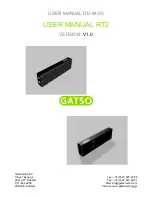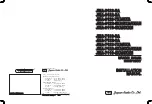
13
To perform the tuning fork test, strike the patrol fork (lower frequency) on a hard nonmetallic
surface. Hold the ringing fork in a fixed position two or three inches in front of the antenna with
the narrow edge of the fork facing the antenna. The speed will be shown in the patrol window.
While continuing to hold the ringing fork in place, strike the other fork and hold it next to the patrol
speed fork. Both forks must be vibrating while being held an approximately-equal distance from
the antenna.
For opposite direction moving mode, the radar should display the low speed fork as patrol and the
difference between the forks as the target speed. For example, for forks marked 35 mph and 65
mph, the patrol would read 35 (low speed fork) and the target would read 30 (high-speed fork
minus low speed fork).
Testing the same direction moving mode with tuning forks is a little more difficult. The radar will
display the high-speed fork as the patrol speed. The PYTHON III assumes that the target is
moving faster than the patrol speed (press the FAST button until the Fast indicator is lit in the
middle window). Therefore, with forks marked 35 mph and 65 mph, the patrol would read 65
(high speed fork) and the target would read 100 (high-speed fork plus low speed fork). To
simulate the other case, where the target is moving slower than the patrol vehicle (press the FAST
button until the Fast indicator is off in the middle window). This makes the radar subtract the
target speed from the patrol speed. With forks marked 35 mph and 65 mph, the patrol would read
65 (high speed fork) and the target would read 30 (high-speed fork plus low speed fork).
Harmonic detection
In moving mode, the PYTHON III receives a large reflection from the road, which is used to
compute the patrol speed. Some situations, such as when guard rails or large signs are present,
cause the signal to be excessively large. This can sometimes cause a harmonic frequency of twice
the patrol speed to appear. These signals would normally be displayed as a target with a speed
equal to the patrol speed and prevent the PYTHON III from reading the speed of real targets, but
harmonic detection circuitry inside the PYTHON III inhibits this and blanks the target display and
activates the HAR indicator on the right side of the middle window. Unfortunately, the harmonic
detection circuitry also may reduce the range of actual target vehicles that are moving at the same
speed as the patrol vehicle. This is normal and can be avoided by patrolling at a different speed
than the offending targets.
Range and radar placement
The range of the radar is influenced by how it is mounted in the vehicle. Heater fans are moving
targets and will be picked up if energy from the antenna is reflected toward the fan. The best
solution to this problem is to find a location that minimizes this effect. To determine this location,
place the unit in stationary mode, turn the volume up, and open the squelch. This lets any target or
interference be heard. If changing fan speeds changes the audio signal, the fan is being picked up
in that mounting position; try to find a different location. Reducing the fan speed may also reduce
the problem. Reducing the range setting of the radar will also reduce the problem. If you have
persistent problems with the PYTHON III reading the fan speed, call the factory for suggestions
specific to your particular vehicle.
















































